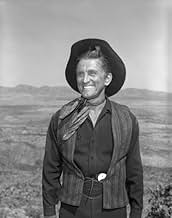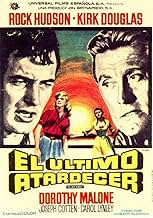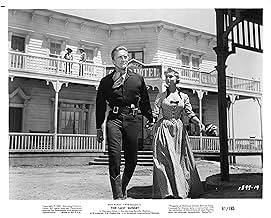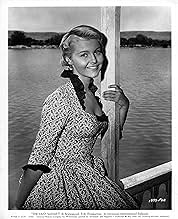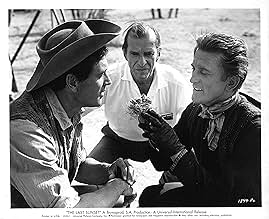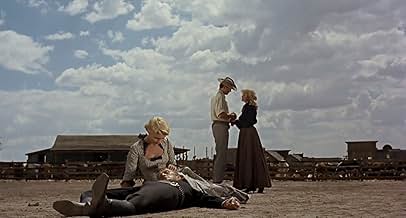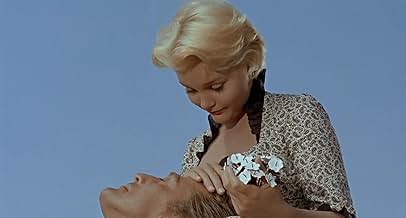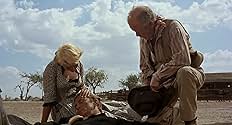Adicionar um enredo no seu idiomaAt a Mexican ranch, fugitive O'Malley and pursuing Sheriff Stribling agree to help rancher Breckenridge drive his herd into Texas where Stribling could legally arrest O'Malley, but Breckenri... Ler tudoAt a Mexican ranch, fugitive O'Malley and pursuing Sheriff Stribling agree to help rancher Breckenridge drive his herd into Texas where Stribling could legally arrest O'Malley, but Breckenridge's wife complicates things.At a Mexican ranch, fugitive O'Malley and pursuing Sheriff Stribling agree to help rancher Breckenridge drive his herd into Texas where Stribling could legally arrest O'Malley, but Breckenridge's wife complicates things.
- Direção
- Roteiristas
- Artistas
- Prêmios
- 1 indicação no total
- Julesburg Kid
- (as Rad Fulton)
- Singing ranch hand
- (não creditado)
- Bartender saloon
- (não creditado)
- Man at Cock Fight
- (não creditado)
- Man in saloon
- (não creditado)
- Man at Saloon
- (não creditado)
- Man in saloon
- (não creditado)
- Direção
- Roteiristas
- Elenco e equipe completos
- Produção, bilheteria e muito mais no IMDbPro
Avaliações em destaque
Although a bit too plodding in places, there are enough surprises throughout the film to make this a less predictable film than many of it's contemporaries. It all builds towards a surprising and welcome ending.
Kirk Douglas is at his captivating best as the anti-hero. He easily outshines Rock Hudson but to be fair his character is far more interesting. Good support is provided by Dorothy Malone and I thought Carol Lynley did a good job as the daughter.
With a more energetic script this really could have been a great western and it's a shame that despite the great final scenes, it is merely above average. Saying that it's still worth watching for fans of the western genre.
Made in 1961, this film is a fine example of an art form that was dying - the 1950's western. John Wayne carried on making them for a few years more (and arguably up to "The Shootist"), but by 1964, three years after this picture, the Spaghetti Western had arrived, and the genre was transformed for ever. The 1950's in Europe and America was an era of social stability - some would say stagnation - and the western reflected the values of the rigid, disciplined society which produced it. Plots did not vary much, innovation not being something that audiences craved, and storylines turned on predictable devices like cattle stampedes, indians on the skyline, fast draws and a man doing what a man's got to do. This film happens to contain all of these stock ingredients.
Man's desire for woman is a theme running through the story in deftly-worked permutations. Dalton Trumbo's better than average script has older men lusting after younger women, men harbouring fantasies of lost love, bad guys leering at decent matrons, and much more. Belle is made a chattle in her husband's droving contract, and receives a new proposal of marriage under the flying buttresses of a Mexican church. In keeping with the film's symbolic structure, she reserves her response until the Rio Grande has been crossed (Mexico seems to preserve the Americans in aspic, preventing them from advancing their plans, just as the church architecture encloses Belle and her lover).
"The Last Sunset" is several cuts above the average western. Its plot situation, the pursuit of one man by another and the involvement of a ranching family, is neatly established at the outset with minimal dialogue. The immediate sexual electricity between O'Malley and Belle engages the viewer, and O'Malley's little comic touches convey his charm and 'open him up' for the viewer. Belle's inner conflict is quickly made plain for us, and O'Malley's behaviour (graciously allowing her to leave the barn) is psychologically interesting, suggesting that he is certain of her. We want to know more about these characters. Much is achieved with the merest of glances, as when Breckenridge tells O'Malley "everything that's mine is yours", and O'Malley darts a look at Belle, or the glance thrown by Stribling when he realises why O'Malley is taking the appalling risk of returning to Texas.
Expert editing by Michael Luciano enhances the effectiveness of the movie considerably. When O'Malley teaches the Julesburg Kid a lesson on horseback, elliptical cutting skilfully evokes the Kid's sense of dizziness and confusion. At the final shoot-out, the accelerating rapidity of the cuts increases the tension brilliantly. There is one small lapse at the start of the cattle drive - the pick-up shot of O'Malley fording the river (overcast sky) does not match the master shot (bright sunshine).
O'Malley's song, "Pretty Girl In The Yellow Dress", runs through the film as a motif. It is a central symbol, because O'Malley's idealistic and doomed vision of Belle is transferred to Missy when she dons the dress - "a new smell to follow".
Admirable though it is, the film does have some weak points. Would Breckenridge REALLY accept O'Malley's second precondition? Would the wily O'Malley REALLY shoot the indian so rashly? The grassy bank on which O'Malley and Missy recline is patently a studio fabrication, bearing no resemblance to the parched earth of the location shots. Stribling's final comment on the derringer is clumsy overkill. We all got the point.
Good use is made of locations, especially old Spanish architecture like the crumbling aqueduct. The brick arches seem to be enveloping the Americans, just as their lives are stalled by being here in Mexico. Attractively-shot silhouettes adorn the dust-storm sequence, particularly during the quicksand episode. Once back in Texas, O'Malley is emblematically shut in by corral fences, a man left with nowhere to go. The film's great punchline, delivered by Belle on the verandah, is truly shocking.
Kirk Douglas and Rock Hudson, O'Malley and Stribling respectively, appear above the title (Douglas's own production company, named after his mother, financed the picture). Douglas is appealing and charismatic in one of his many 'generous-hearted bad guy' roles. Hudson is perfectly adequate in the straight-down-the-line part of Stribling, and looks terrific. The character of Belle, with her internal contradictions and the aura of having been buffeted by life, calls for an actress with both beauty and intelligence. Dorothy Malone is ideal in the role. Carol Lynley does very well as Missy, making a great transition from gawky kid to radiant woman. If Joseph Cotten fails to shine, it must be said that the part of Breckenridge is a dreary one. Neville Brand and Jack Elam turn in stock performances: as jobbing bad guys throughout the 1950's and early 60's, they must hardly ever have needed to shave.
Verdict - Interesting western with powerful denouement.
Robert Aldrich does a very controlled job directing a story straddling the Texas Mexico border, a story told at a steady pace but rarely reaching memorable highs. The film has many elements of the classic Western including a chase, cattle drive and gunfight but it also tries to add some melodramatic, pure story based elements - though one major plot point was so well signposted, it might as well have been included in the opening credits.
Kirk Douglas, as Brendan O'Malley, provides the barely controlled dynamism at the centre of the film. Unfortunately, not all parts of the film are to this standard. Rock Hudson has difficulties with the role of the upstanding sheriff. A strong supporting cast, from Joseph Cotton to Jack Elam, provides a wide, interesting range of characters.
Overall, a solid if unspectacular film, recommended for Western and Kirk Douglas fans. 6.75.
I personally recall the loud arguments my father (living in the USA at the time) would have with his cousin Salvador, who swore that Rock Hudson had been seen in town with the local (and few) homosexuals. In 1961, my father believed that it was impossible for Rock to be anything but the All-American (straight) male image he projected on the screen. My dad laughs about it now.
Você sabia?
- CuriosidadesThis movie had a major influence on Sergio Leone, who worked with director Robert Aldrich on Sodom and Gomorrah (1962).
- Erros de gravaçãoTwo of the dresses worn by Missy (the yellow one and the floral one in town) have zippers up the back. Not a goof: women's clothing in the 1880s was fastened with a series of hook-and-eyes attached to twill tape. The way this tape was sewn into dress and skirts is the same way modern zippers are sewn.
- Citações
Belle Breckenridge: To me, it always seems like it's the women who keep on living. Men kill or get killed and women bury them. We're professional survivors.
- ConexõesFeatured in Rock Hudson's Home Movies (1992)
- Trilhas sonorasPretty Little Girl In The Yellow Dress
Music - Dimitri Tiomkin
Lyric - Ned Washington
Performed by Kirk Douglas (uncredited)
Principais escolhas
- How long is The Last Sunset?Fornecido pela Alexa
Detalhes
Bilheteria
- Orçamento
- US$ 3.500.000 (estimativa)
- Tempo de duração
- 1 h 52 min(112 min)
- Proporção
- 1.85 : 1


